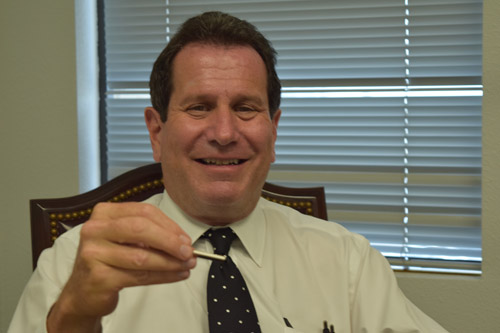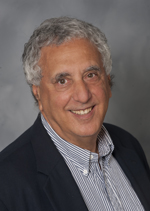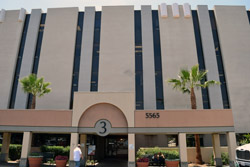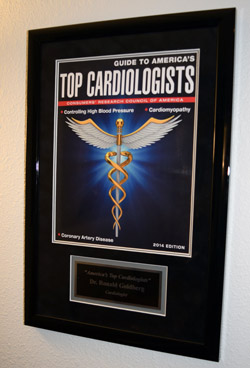
-43rd in a series-
Exit 14A, Grossmont Center Drive, La Mesa, California ~ La Mesa Cardiac Center
By Donald H. Harrison


LA MESA, California –Dr. Ronald Goldberg, the senior of three physicians at the La Mesa Cardiac Center on the campus of Sharp Grossmont Hospital, tells of a woman who periodically and for no apparent reason fainted dead away, but doctors could find no cause for her doing so.
Taken to a hospital, she would be given an electrocardiogram but each time her EKG appeared normal. Similarly, other tests in the hospital indicated no discrepancies. The woman became increasingly distraught. She was afraid to leave her house, and especially to drive a car, lest she faint where she might be most vulnerable, or cause harm to herself and others. She worried herself to the point of being neurotic. Doctors, unable to find any other reason for the fainting, wrote off her episodes as psychosomatic. They concluded that the trouble was not in her heart, but in her head.
Subsequently, Metronic, a biomedical company in Minneapolis, invented a device that could be implanted in a person’s chest and enable the patient’s heart activity to be continuously monitored. It took about ten minutes of surgery to implant the device inside the woman’s chest cavity. A computer inside the device recorded heart rhythms whenever it sensed unusual activity. The recordings could be transmitted to an exterior computer which could relay the information to a printer.
Dr. Goldberg said that only two days after he implanted the device, the patient came into the office and said “It happened again.” This time, there was information from the device to analyze and Goldberg learned that his patient “was having periods when her heart stopped for several seconds and this was causing her to pass out. So we put a pacemaker in, and she felt wonderful. She wasn’t ‘neurotic’ anymore because she no longer was afraid to go out.”
Patients with cardiac problems do not necessarily exhibit the symptoms on a regular basis; they can occur infrequently, Goldberg said. The purpose of the implanted monitor is to “capture whatever it is that they are feeling” whenever the symptoms occur.
The cardiologist said Metronic subsequently invented an even smaller version of the device, one which can be implanted under the skin in a procedure that takes “about a minute.” Currently Medicare requires for payment that the procedure be performed in a hospital, but Goldberg says in reality it’s simple enough to implant during an office visit. Goldberg spent two days with Metronic in Minneapolis, along with other cardiologists from around the country, in a seminar suggesting design changes for the newer device, known as the “Reveal.”

He said he was one of the first cardiologists in San Diego to perform the procedure with the newer device in 2013, and that since that time he has implanted several such devices per month.
Goldberg was born in Flint, Michigan, and was moved by his family to Phoenix when he was four years old. As a youngster he had “very bad allergies, and I was in the emergency room all the time. A pediatrician would let me look in his microscope” and that, plus his mother’s urging, led him to want to become a doctor. Some of the important steps in his life were a bar mitzvah at Temple Beth Israel in Phoenix; college mostly in Arizona, medical school at the University of Arizona, cardiology training at Baylor University in Houston, and moving to San Diego County in 1989, where he and his wife, Ann, reside in the Mt. Helix area of La Mesa. Ann Goldberg volunteers as the president of the Grossmont Hospital Foundation.
The La Mesa Cardiac Center, at 5565 Grossmont Center Drive, Suite 455, takes “care of patients with coronary disease, heart failure, and abnormal heart rhythms,” Goldberg said. “My primary specialty is interventional cardiology in which we open up arteries with angioplasty, and put in stents.
“I also do pacemakers, so I tell patients I do ‘major plumbing and minor electrical work,’” he quipped.
“I have grown up at the same time as interventional cardiology,” he said. “When I was in medical school my father had a heart attack and ended up in the hospital in Phoenix. When he was there, basically all they did was give the patient morphine and put ‘em in bed, and basically watched you … They waited for something bad to happen. As I progressed through my training all these new treatments became available. So now when someone comes to our hospital with a heart attack we rush them to the cath lab (catheterization laboratory); we open up the arteries; and we prevent most of the damage. So it has been very gratifying to see how things have evolved from the time I was basically training. Our death rate from heart attacks is going down because of all that is available.”
He also said: “I was really one of the first trained interventionists to come to the program. The program grew pretty quickly after 1989, when we started doing things differently. I would say I am pretty responsible for where the interventionist program at Grossmont is today.”
I asked the cardiologist if he had any heart-healthy tips he’d like me to pass along.
“One of the main epidemics nowadays is obesity and that is leading to diabetes and that is going to be a huge health problem in the future because diabetes causes heart disease, causes stroke, causes kidney failure – you name it – and so the key risk for the population is obesity,” he responded.
“In terms of diet, unfortunately what has happened is that fats got a bad name and carbohydrates became our way of life, and that is probably what has led to this obesity. It turns out that the FDA (Food and Drug Administration) came up with the low-fat, heart-healthy diet but it was never based on good research. So now they are saying it’s okay to eat eggs again. It turns out that eating cholesterol in eggs and eating fat is not the culprit; it is more of the carbohydrates that is causing the problems.
“So I think we are going to see a shift to much lower carbohydrate, higher fat diets,” he added. “That will be similar to what we ate a long time ago when we didn’t have all these issues.”
I asked what is included in his own diet.
“In large part, it’s a Mediterranean diet,” he said. “Hummus, fish, chicken, a lot of vegetables. My wife is on a similar diet, with no carbohydrates. She tries to keep no bread nor pasta in the house.”
No bagels either? I asked crest-fallen.
“Not generally,” he said with a smile. “I try to get those when I go on vacation.”
*
From Grossmont Center Drive exit proceed north on Grossmont Center Drive to a right turn at Center Drive and parking lot.
Next: Opera diva helped launch art colony
*
Harrison is editor of San Diego Jewish World. You may comment to him at donald.harrison@sdjewishworld.com, or post your comment on this website provided that the comment is civil and that you identify yourself by your full name and by your city and state of residence.